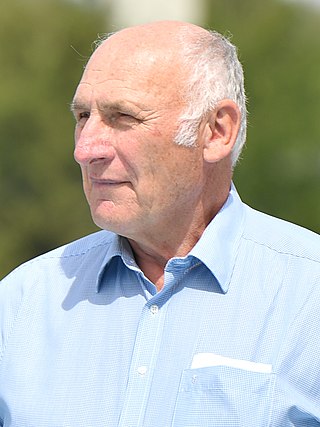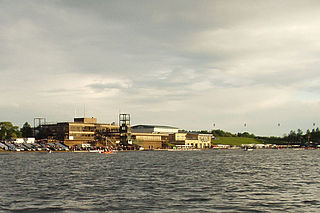
Alf John Hansen is a retired rower from Norway. Early in his career, he received two Norwegian sport awards shared with his brother Frank. Towards the end of his career in 1990, he was the inaugural recipient of the Thomas Keller Medal, the highest honour in rowing. His international rowing career spanned more than two decades.

Igor Aleksandrovich Rudakov is a Russian former coxswain who competed for the Soviet Union in the 1960, 1964, 1968, and in the 1972 Summer Olympics.

Hans-Johann Färber is a German rower who competed for West Germany in the 1968 Summer Olympics, 1972 Summer Olympics and in the 1976 Summer Olympics.
The 1962 World Rowing Championships were the inaugural world championships in rowing. The competition was held in September 1962 on the Rotsee in Lucerne, Switzerland. Rowers from West Germany dominated the competition, winning five of the seven boat classes.

The 1966 World Rowing Championships was the second time that world championships in rowing were held. The regatta was held from 8 to 11 September at Lake Bled in Bled, Slovenia, Yugoslavia. There were 613 rowers from 32 countries who competed in the seven Olympic boat classes. Marketing and advertising for the event were handled by Cesar Lüthi.
The 1970 World Rowing Championships was the 3rd World Rowing Championships. It was held in 1970 at the Royal Canadian Henley Rowing Course in St. Catharines, Ontario, Canada. The competition involved seven events. Prior to the 4th World Rowing Championships in 1974, only men competed.

The 1975 World Rowing Championships was the fifth World Rowing Championships. It was held from 21 to 30 August at Holme Pierrepont National Watersports Centre in Nottingham, England, United Kingdom.

The 1964 European Rowing Championships were rowing championships held on the Bosbaan regatta course in the Dutch capital Amsterdam. Women competed from 31 July to 2 August. Men competed the following week from 6 to 9 August. Men competed in all seven Olympic boat classes, and women entered in five boat classes. Many of the men competed two months later at the Olympic Games in Tokyo; women would first be allowed to compete at Olympic level in 1976.

The 1965 European Rowing Championships were rowing championships held on the Wedau regatta course in the West German city of Duisburg. This edition of the European Rowing Championships was held from 20 to 22 August for women, and from 26 to 29 August for men. Women entered in five boat classes, and 12 countries sent 36 boats. Men competed in all seven Olympic boat classes, and 22 countries sent 89 boats. East German crews did not attend the championships.
The 1969 European Rowing Championships were rowing championships held on the Wörthersee in the Austrian city of Klagenfurt. This edition of the European Rowing Championships was held from 5 to 7 September for women, and a few days later for men. Women entered in five boat classes, and 15 countries—including the United States—sent 47 boats. Men competed in all seven Olympic boat classes. An innovation was that petite finals were held to determine places 7 to 12.
The 1957 European Rowing Championships were rowing championships held on the Wedau Regatta Course in the city of Duisburg which, at the time, was located in West Germany. Men competed in all seven Olympic boat classes, and women entered in five boat classes. Many of the men competed two months later at the Olympic Games in Melbourne; women would first be allowed to compete at Olympic level in 1976. Women competed from 23 to 25 August. Men competed the following week.
The 1956 European Rowing Championships were rowing championships held on Lake Bled in the city of Bled which, at the time, was located in Yugoslavia. Men competed in all seven Olympic boat classes, and women entered in five boat classes. Many of the men competed two months later at the Olympic Games in Melbourne; women would first be allowed to compete at Olympic level in 1976.

The 1954 European Rowing Championships were rowing championships held on the Bosbaan regatta course in the Dutch city of Amsterdam. This edition is particularly notable for the fact that it was the first time that women were allowed to compete as part of the championships, after three years of trial regattas for them. Women from 13 countries were represented with 34 boats, and they competed in five boat classes from 20 to 22 August. The men competed in all seven Olympic boat classes a week later, from 26 to 29 August. It would be another 22 years until women would first be allowed to compete at Olympic level in 1976.
The 1963 European Rowing Championships for men were rowing championships held on Lake Bagsværd near the Danish capital Copenhagen; the competition for women was held the following month in Moscow. The regatta in Copenhagen was held from 14 to 18 August.
Stefan Voncken is a German coxswain.
Boris Fyodorov is a Soviet rower. He had a long career, having won international medals between the ages of 22 and 35.
The 1953 European Rowing Championships were rowing championships held on Lake Bagsværd near the Danish capital Copenhagen. Men competed in all seven Olympic boat classes. The regatta was also the third test event for international women's rowing organised by the International Rowing Federation (FISA), with nine countries competing in four boat classes over the shorter race distance of 1,000 m. The purpose of the test event was to see whether women's rowing should formally become part of the FISA-organised European Rowing Championships.
The 1950 European Rowing Championships were rowing championships held on the Idroscalo in the Italian city of Milan. The competition was for men only, they competed in all seven Olympic boat classes.
The 1951 European Rowing Championships were rowing championships held on the Mâcon regatta course on the Saône in Mâcon, France. Men competed in all seven Olympic boat classes. The regatta is notable as the first test event for international women's rowing organised by the International Rowing Federation (FISA), with four countries competing in four boat classes over the shorter race distance of 1,000 m. The purpose of the test event was to see whether women's rowing should formally become part of the FISA-organised European Rowing Championships.
The 1926 European Rowing Championships were rowing championships held on Lake Lucerne in the Swiss city of Lucerne. The competition was for men only and they competed in all seven Olympic boat classes.







